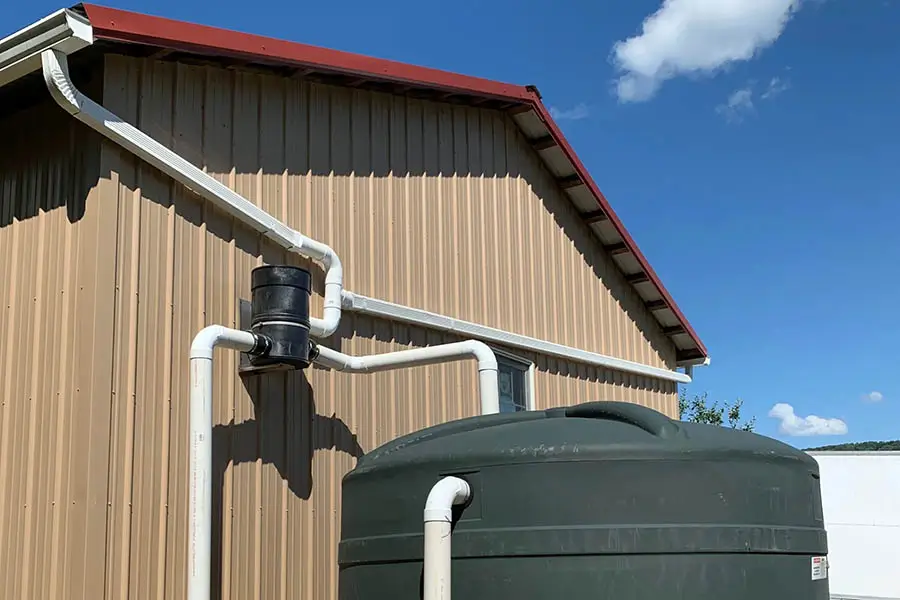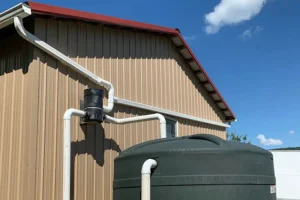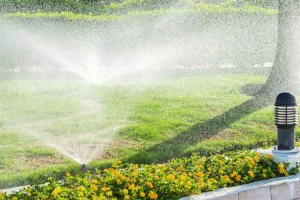A rainwater harvesting system is designed to collect and store rainwater for later use. The system typically involves a collection area, such as your roof, gutters, and downspouts, which direct rainwater into a tank or cistern.
Homeowners looking for the best residential rainwater harvesting installation can benefit from systems that efficiently filter, store, and distribute collected water for irrigation, outdoor watering, or even potable use, depending on the filtration setup you choose.
How Does the System Work in Austin?
Living in Austin, we experience heavy rain events followed by long dry spells. Our rainwater systems capture that water for use during dry months, which is especially helpful for maintaining landscapes, lawns, and outdoor spaces.
We’ve installed systems in Round Rock, Pflugerville, and even as far out as Dripping Springs, all designed to optimize water usage while lowering reliance on municipal supplies.
What Are the Benefits of Installing a Rainwater Harvesting System?
Conserving Water
With rainwater harvesting, you collect water from the roof and gutters of your home, saving it for future use. This is especially helpful during times when water restrictions are in place, allowing you to water plants or wash your car without tapping into the public water supply.
Reducing Your Water Bill
Using rainwater instead of municipal water for irrigation can help lower your water bills. This is a smart way to cut costs while making a positive environmental impact. At Austex Sprinklers, we’ve helped many homeowners upgrade from a simple rain barrel to a full rainwater collection system.
Sustainability
Installing a rainwater harvesting system helps contribute to a more sustainable future. You’ll reduce your water consumption, helping to alleviate the strain on the city’s water supply and lowering your carbon footprint.
How to Install a Rainwater Harvesting System in Austin, TX?
Choosing the Right System for Your Needs
At Austex Sprinklers, we customize every system we design and install. We ensure that your system fits your unique water needs, the size of your roof, and your desired water usage.
Cisterns or Rain Barrels?
You can start small with a rain barrel or go for a larger cistern, depending on how much rainwater you plan to collect. Larger cisterns can hold anywhere from 500 to 2,500 gallons of water, ensuring a steady supply during dry spells.
Gutter and Downspout Installation
Your home’s gutters and downspouts will play a major role in directing water from your roof into your rainwater collection system. Proper installation ensures that the system functions smoothly and minimizes water loss.
Filtration and Water Quality
For potable water use, it’s important to have a reliable filtration system to remove debris and contaminants. For non-potable use, a simpler filtration system may suffice. We provide tailored solutions to ensure your rainwater is safe for its intended use.
How Does a Rainwater System Help During Droughts?
Storing Water for Future Use
When drought hits, your rainwater system acts as a backup water source. By harvesting water during rainy months, you have a reliable supply when rainfall is scarce. This helps mitigate the effects of drought in Austin and other parts of Central Texas.
Using Harvested Water Efficiently
You can use harvested rainwater for irrigation, fire protection, or even drinking water (with the right filtration).
This makes your home or business more resilient during water shortages, which is becoming an increasing concern in the Hill Country and other parts of Texas.
Is Rainwater Harvesting Cost-Effective?
Many homeowners in Austin and surrounding areas are eligible for rebates and incentives when installing rainwater systems. The City of Austin offers programs to encourage water conservation, which can help offset the installation costs.
Over time, the savings on water bills and the environmental benefits will make the investment worthwhile.
How Does a Rainwater Harvesting System Help with Fire Protection?
In areas like the Hill Country, drought conditions increase the risk of wildfires. With a large rainwater tank, you have a water source that can be used for fire protection. Curious about how these systems supply reliable water when you need it most?
Learn more about how a rainwater collection system works and how rainwater harvesting solutions can be integrated with pressurized pump systems to ensure you can access water quickly during emergencies.
This provides peace of mind for residents in fire-prone areas, knowing that they have a reliable water source at their disposal when it matters most.
Frequently Asked Questions About Residential Rainwater Collection Systems
1. Can rainwater harvesting help reduce drought effects in Austin?
Yes, rainwater harvesting systems provide a reliable backup water source during dry periods, reducing dependence on municipal water.
2. Is it expensive to install a rainwater harvesting system?
Yes and no. While installation costs can vary, rebates and long-term savings on water bills make it a worthwhile investment.
3. Can I use rainwater for drinking?
Yes, with the proper filtration system, rainwater can be used for potable water.
Conclusion
Rainwater harvesting systems are a fantastic way to combat drought conditions in Austin, TX, while conserving water and saving money.
At Austex Sprinklers, we specialize in the design and installation of customized rainwater collection systems that meet the unique needs of homeowners in the Austin area. If you’re ready to start harvesting rainwater or want to learn more about our services, contact us today.
We’re here to help you install a system that not only reduces your reliance on municipal water but also contributes to a more sustainable future.
Contact Austex Sprinklers today at (512) 721-8564 to get started on your rainwater collection project!




